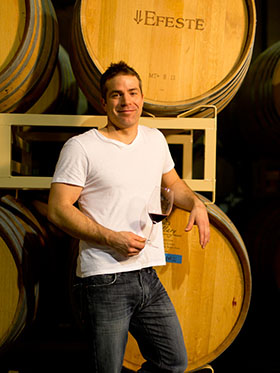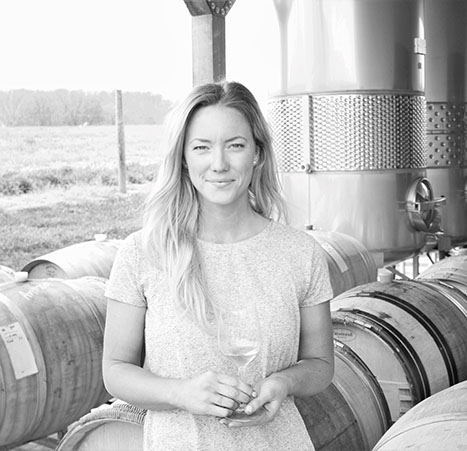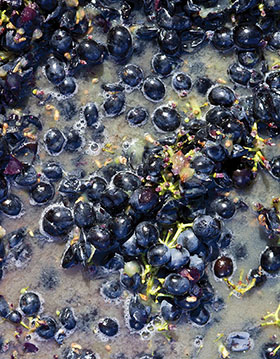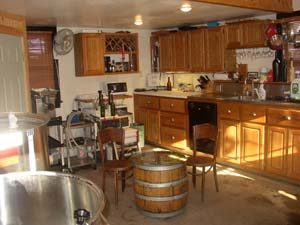Bench trials are a best practice method to monitor your wine through the post-fermentation aging process and assess when intervention is required. Here are some helpful tips on performing bench trials on your own wines.
 Since 2014, Eric Schroeder has created classic cool-climate vinifera wines in the Grand River Valley AVA in northeast Ohio as the Head Winemaker at Laurentia Vineyard and Winery. He has a background in architecture and design, which blend well with the balance of mathematical and scientific aspects of winemaking along with a heavy emphasis on style and the artful influence of technique.
Since 2014, Eric Schroeder has created classic cool-climate vinifera wines in the Grand River Valley AVA in northeast Ohio as the Head Winemaker at Laurentia Vineyard and Winery. He has a background in architecture and design, which blend well with the balance of mathematical and scientific aspects of winemaking along with a heavy emphasis on style and the artful influence of technique.
We have a general process for each of the three main categories of wine that we produce; aromatic whites, oak-aged whites and our reds.
Nearly all of our trials are conducted post-fermentation. We spend a lot of time in the vineyard during the growing season detailing our growing practices to each specific vineyard block to make sure our quality and chemistry are in-line when we hit the press pad. Of course mother nature has a tendency to foil our plans every now and then and in these instances we are usually looking at making adjustments to either acid or pH. As home winemakers however, you are likely to have far less control over the initial chemistry of your juice or fruit. With that being said, it’s important to go into your fermentation understanding what style of wine you’d like to end up with so you can make the proper adjustments. The scale of your operation will also have a significant impact on how well and how accurately you can conduct trials. The smaller your batch the more difficult it becomes. I usually trial acid adjustments in a 500mL format. Typically the additions will be rather small so this size makes it easier to accurately weigh the material you’ll be adding. If acid reduction is necessary I will blend juices to get towards my target number. I’m not a fan of adding potassium (aside from KMBS) or calcium at any stage of the winemaking process. Blending trials are done in a 100mL format at this stage.
Once fermentation is complete, free SO2 levels have been stabilized and the wine has been racked after a 2–3 week settling period, we will begin to put the wines through a series of trials. These are all conducted at 400 mL sizes, which I find to be a convenient size for anything that has to sit for a few days for a complete reaction to occur. It’s easy to mix up on a small stir plate and then pour into a 375mL bottle topped with a tasting cork. The math on trials is easy to work in any multiple of 100 mL so you may be able to get away with smaller sizes if you’re just working with a few carboys or smaller batches.
The aromatic whites will go through a betagluco¬sidase trial at the low, middle and high range suggested for that particular enzyme. We will then look at heat stability and conduct fining trails with bentonite or a chitosan/kieselsol blend. The vast majority of the time I use bentonite but I remember chitosan/kieselsol being much easier and far less messy at home. Chitosan and kieselsol can help reduce some astringency and bitterness as well, which may be beneficial if you end up making wine with a juice that perhaps wasn’t in the best shape at the beginning. Prior to bottling I will look at making small tweaks to acid and sugar if I feel it is needed for balance. Rarely do we make adjustments of more than 0.5% residual sugar to a finished wine and we may make a small tweak on the acid maybe in the range of 0.5–1.0 g/L. I typically don’t do blending trials for the aromatic varieties. These final adjustments are easy to conduct on a smaller 100mL scale. We like to keep them as pure as possible.
Whites that are seeing oak contact are either wines that are being barrel fermented or racked to barrel immediately following fermentation. I skip the betaglucosidase step for the oaked whites as I like to shape the wine by varying the degree of lees contact and through oak selection. Lees are an entirely different animal and that’s sort of a “live-action” trial that you learn as you go. I suppose you can trial your oak selections though. I remember going to a sensory evaluation workshop where one of the participants (who was a home winemaker) brought in about a dozen canning jars full of different oak chips steeped in water. To go through and smell all of those was quite interesting and can be used as a rough way to judge aroma contribution of your chips or segments. Once I’m satisfied with the degree of oak, I will taste through each barrel in the lot and makes notes on aroma, flavor and mouthfeel/structure. I will then begin working on creating the blend from that lot based on what I’ve tasted. These blends are 400 mL and used during blind tasting trials. Once the final blend is established we will follow the same protein fining and cold stabilization process as used on our aromatic whites.
All of our reds see significant time in oak and are relatively stable when we make a decision to bottle. As such, we focus all of our effort towards blending. We do not fine, filter or adjust our reds in any other way other than blending. We have experimented with tannin trials in the past; early as the wines are being barreled down and late when the final blend is being constructed. I feel like these have always resulted in wines that show poor integration and an unharmonious character. If I feel a wine is lacking structure I will do my best to correct for that during the blending process.
As far as the number of samples in your trial I think it depends on what you’re trying to correct/adjust and how far off that sample is from your desired outcome as well as the stage of winemaking that you find yourself in. I would rather put in a lot of analysis early rather than attempt a lot of adjustment late in the game. I like to be as hands off as possible but when working with new varieties or a new vineyard block there will need to be more investigation on how the wine is going to react to different treatments. It’s all part of a learning curve.
Wait times for things like enzymatic and fining trials are often suggested by the product supplier and I typically follow those. My fining trials are evaluated after 48 hours of contact and enzymes are typically 72 hours at room temperature. Final pre-bottling adjustments are evaluated after 1 hour and blending trials for more complex or oak aged wines are allowed to sit for 48-72 hours prior to evaluating.
Most trials that are conducted early in the winemaking process and not directed at significantly altering the final perception of the wine are evaluated by myself. Post fermentation, I will pull samples of all wines and provide them to a panel of 5–6 people for overall evaluation. It’s easy to become cellar blind to a lot of the wines during the harvest season. Luckily we have some excellent palates on staff that can identify potential flaws and issues that I may have missed. When we get into the blending process and pre-bottling adjustments I will typically run through 2 or 3 rounds of 4 samples of each wine to arrive at a solid starting point that I will then pass along to this same panel for feedback.
You should go with your gut and your first instinct is usually correct. There is definitely a point where evaluations can become overwhelming and the samples will quickly start to bleed together and may even become indistinguishable. I will usually visit a set of samples three times with a short 10-15 minute break in between each evaluation. If I am having other evaluate the samples we will follow the same pattern but in a group setting.
Evaluations should always be done blind! Basically just the statistics are shared about the wine: Varietal, vintage, and type of trial. When we evaluate we also keep our opinions/notes to ourselves until everyone has finished evaluating, we then open up a discussion and will visit the wines one more time. Through this process we are able to make big leaps of progress.
Then I save all of my notes. I have so many notebooks! They are an indispensible resource and one of the most important tools I have at my disposal. I’m always writing and recording. It’s a must. The reason winemaking is so much fun is that you continually build on what you’ve learned in the past. While each vintage is certainly unique, history plays a critical role in honing your craft and is hugely informative in shaping your wines.
Take your time and be accurate when setting up your trials. Double check your math, your weights, volumes etc. Be patient with yourself as you work through the learning curve of different wines and new types of trials. I’ve botched many trials myself but take the time to do them over and do them correctly. Chances are if you live in or near a viticultural area there are a lot of resources at your local wineries, don’t be afraid to ask for pointers or help.
 Peter Devison is the Winemaker at EFESTÉ in Woodinville, Washington. Peter earned his Bachelor of Applied Science in Viticulture and Oenology at Lincoln University in New Zealand. Fourteen years, four countries, and 17 harvests later, Peter employs a distinctive Old World winemaking style taking steps to limit the wine’s exposure to oxygen and allowing the vineyard and vintage to do its thing with limited intervention.
Peter Devison is the Winemaker at EFESTÉ in Woodinville, Washington. Peter earned his Bachelor of Applied Science in Viticulture and Oenology at Lincoln University in New Zealand. Fourteen years, four countries, and 17 harvests later, Peter employs a distinctive Old World winemaking style taking steps to limit the wine’s exposure to oxygen and allowing the vineyard and vintage to do its thing with limited intervention.
At EFESTÉ I focus on a hands-off approach to my winemaking and thus conduct very few trials in the lab apart from blending, which is done at two times throughout the year: (1) pre-harvest (August), as we rack the previous year’s wines for the first time off lees, and (2) when moving the final wines to tank for bottling. At these points I’m looking at shape and style; the only numbers used are percentages and volumes.
The parameters for this testing are simple: Pull each sample from every vessel in the lot, making sure the appropriate volumes are taken, code the samples so that I can taste/blend blind, and pull enough sample volume so that I can go back and revisit the blend(s) a second time the following day. I always involve my assistant winemaker when conducting blending trials and evaluate the wines blind. We usually put several sample blends together that are fairly different from each other to see what direction I want to go in. Once that’s decided we put together another set of samples that are similar to the chosen direction from flight one. This continues until I come up with a flight in which the samples vary only slightly (as in a small percentage difference of a certain varietal, more or less new oak, etc.). Once I choose the final blend I conduct a triangle test to determine if it is significantly different and better than the second choice. The next day a reassemble the chosen blend to confirm.
With blending, the evaluation can be very short (as in minutes), or extremely long (as in setting up fresh trials every few days for weeks). The key with bench trials for blending is to know when your palate is fatigued. This will depend on the type of wine, as high acidity and higher tannin concentrations in certain varieties/lots can be difficult to assess in high numbers. There is also the phenomenon I call “nose blindness,” which is when you have been smelling a particular aroma or compound at such a level or length of time that you can’t pick it up anymore. Knowing when your retro-nasal/olfactory senses are compromised is important.
Every vintage and blending session is treated independently. I keep more notes between blending sessions, as I taste routinely to monitor for wine health and evolution. When it comes to the actual blending trials, I refer to my notes to have a beginning direction for where I thought the wine might go, although sometimes the trial takes me so far away from my original notes that it could take several weeks and trials to get the blend right. Other times the first trial is successful.
My biggest advice is don’t get caught up in the “making” part of winemaking. Often times people can get too aggressive with trials and think they need to add or remove undesirable components that may evolve into pleasant characters with a little time. Don’t react. Keep the wines clean and cool and think before messing with them. Impatience can kill a wine. If you need to conduct trials, do it blind, at cellar temperature, don’t rush it, and go with your heart. Winemaking follows the same law as everything else worth doing: You get out of it what you put into it.
 Lisa Hinton is the winemaker of Old Westminster Winery (Westminster, Maryland), as well as co-founder with her siblings, Drew and Ashli. A chemist by education, Lisa prides herself in crafting wines that reflect the region’s many unique geologies and climate.
Lisa Hinton is the winemaker of Old Westminster Winery (Westminster, Maryland), as well as co-founder with her siblings, Drew and Ashli. A chemist by education, Lisa prides herself in crafting wines that reflect the region’s many unique geologies and climate.
Old Westminster Winery focuses on low-intervention wines that reflect a time and place. Because our wines receive few additions, bench trials are not a common practice. The most regular trials we perform are for blending.
As we perform our blending trials, four of us taste blindly to avoid bias. We each know the purpose of the bench trial but not the difference in each sample. We start by tasting through the wines we have at the end of the aging process — up to 100 barrels. We take detailed notes. I blend different percentages and we taste blindly through them. After deciding what we like, we walk away and come back a month later. We remake all of them and make more adjustments. Then we walk away again and come back a third time before blending a big volume.
All blends are created in 100 mL samples, so each evaluator gets a 25 mL sample. If you’re working with smaller batches as a home winemaker, you can adjust the sample size to fit accordingly. Wines change over time, so we blend with wines that are finished aging to eliminate change between blending and bottling.
We’ve never actually added a fining agent to our wines, but we have done these bench trials on occasion. So why do them if we aren’t going to make the addition? It’s about learning and figuring out what the difference would be. For us, low intervention overrules the difference in wine every time — we would rather create a more authentic expression of time and place than add a fining agent and take something out that is naturally present.
So the process of learning how to do bench trials is important. Even if you’re not going to use them. It’s a great exercise for your senses. Educating yourself about how wines change, knowing your preferences, and how different proteins, blends, or acids affect a wine is important to improve your winemaking.
Keeping notes is key. As you educate yourself on the effect of each trial, you learn that wines behave differently, even within the same vintage and varieties. You can never rely solely on a previous test to predict the outcome of a future trial.


 Peter Devison is the Winemaker at EFESTÉ in Woodinville, Washington. Peter earned his Bachelor of Applied Science in Viticulture and Oenology at Lincoln University in New Zealand. Fourteen years, four countries, and 17 harvests later, Peter employs a distinctive Old World winemaking style taking steps to limit the wine’s exposure to oxygen and allowing the vineyard and vintage to do its thing with limited intervention.
Peter Devison is the Winemaker at EFESTÉ in Woodinville, Washington. Peter earned his Bachelor of Applied Science in Viticulture and Oenology at Lincoln University in New Zealand. Fourteen years, four countries, and 17 harvests later, Peter employs a distinctive Old World winemaking style taking steps to limit the wine’s exposure to oxygen and allowing the vineyard and vintage to do its thing with limited intervention. Lisa Hinton is the winemaker of Old Westminster Winery (Westminster, Maryland), as well as co-founder with her siblings, Drew and Ashli. A chemist by education, Lisa prides herself in crafting wines that reflect the region’s many unique geologies and climate.
Lisa Hinton is the winemaker of Old Westminster Winery (Westminster, Maryland), as well as co-founder with her siblings, Drew and Ashli. A chemist by education, Lisa prides herself in crafting wines that reflect the region’s many unique geologies and climate.




